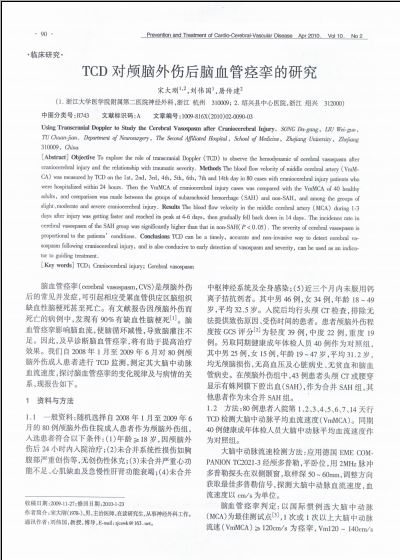TCD对颅脑外伤后脑血管痉挛的研究(1)
 |
| 第1页 |
参见附件(1613KB,3页)。
中图分类号:R743 文献标识码 :A 文章编号:1009_816X(2010)02_0090_03
Using Transcranial Doppler to Study the Cerebral Vasospasm after CraniocerebralInjury.SONG Da_gang, LIU Wei_guo, TU Chuan_jian. Department of Neurosurgery, Th e Second Affiliated Hospital, School of Medicine, Zhejiang University, Zhejiang310009, China
[Abstract] ObjectiveTo explore the role of transcranial Doppler (TCD) to observ e the hemodynamic of cerebral vasospasm after craniocerebral injury and the rela tionship with traumatic severity.MethodsThe blood flow velocity of middle cere bral artery (VmMCA) was measured by TCD on the 1st, 2nd, 3rd, 4th, 5th, 6th, 7thand 14th day in 80 cases with craniocerebral injury patients who were hospitali zed within 24 hours. Then the VmMCA of craniocerebral injury cases was comparedwith the VmMCA of 40 healthy adults, and comparison was made between the groupsof subarachnoid hemorrhage (SAH) and non_SAH, and among the groups of slight、m oderate and severe craniocerebral injury.ResultsThe blood flow velocity in themiddle cerebral artery (MCA) during 1_3 days after injury was getting faster andreached its peak at 4_6 days, then gradually fell back down in 14 days. The inc idence rate in cerebral vasospasm of the SAH group was significantly higher thanthat in non_SAH(P<0.05). The severity of cerebral vasospasm is proporti onal to the patients' conditions.ConclusionsTCD can be a timely, accurate and non_ invasive way to detect cerebral vasospasm following craniocerebral injury, and i s also conducive to early detection of vasospasm and severity, can be used as anindicator to guiding treatment.
[Key words] TCD; Craniocerebral injury; Cerebral vasospasm
脑血管痉挛(cerebral vasospasm,CVS)是颅脑外伤后的常见并发症,可引起相应受累血管 供应区脑组织缺血性脑梗死甚至死亡。有文献报告因颅脑外伤而死亡的病例 中,发现有90%有缺血性脑梗死[1]。脑血管痉挛影响脑血流,使脑循环减慢,导致 脑灌注不足。因此,及早诊断脑血管痉挛,将有助于提高治疗效果。我们自 2008年1月至2009年6月对80例颅脑外伤成人患者进行TCD监测,测定其大脑中动脉血流速度 ,探讨脑血管痉挛的变化规律及与病情的关系,现报告如下。
1 资料与方法
1.1 一般资料: 随机选择自2008年1月至2009年6月的80例颅脑外伤住院成人患者作为颅脑外伤组 ......
您现在查看是摘要介绍页,详见PDF附件(1613KB,3页)。